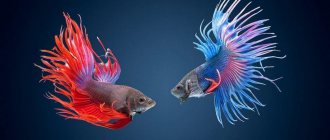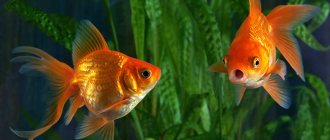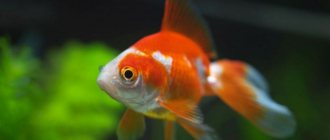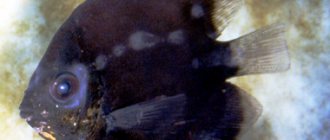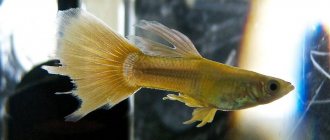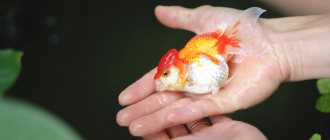Goldfish are a real favorite of aquarium owners. These pets are graceful and bright. They immediately attract the eye. They are interesting to watch. Swimming fish calms the nerves. Like any other pet, aquatic creatures can get sick. The owner must detect deviations in time and take action. To do this, he needs to know what goldfish diseases exist, what their symptoms are and how to deal with them.
A healthy fish is always active, its scales are shiny, and its color is bright and not dull. An indicator that your pet is okay is his appetite. If he's missing, you should worry. Perhaps the golden beauty is sick with something.
What could be the reason?
There may be several reasons why the water in an aquarium takes on a milky tint.
New Aquarium Syndrome
When you first start an aquarium, it takes time to establish balance in it. Beneficial bacteria, plants and other inhabitants have not yet become full participants in the nitrogen cycle.
It proceeds according to the following scheme:
- A high concentration of ammonia is created, which is produced by fish.
- The population of bacteria that process ammonia is increasing.
- Ammonia levels drop, but equally toxic nitrites appear in large quantities.
It is at these stages that the increased concentration of ammonia in the water, and then nitrites, causes the water to turn white.
The cycle ends with the birth of bacteria, which oxidize nitrites, releasing the final product - nitrates . These are no longer such “evil” bacteria, and their level is easily regulated by nature itself. Bacteria begin to work as a biofilter, simultaneously reducing the whiteness of the aquatic world.
Another reason for whitish water is the use of poorly washed soil when starting the system. This usually appears soon after filling the aquarium.
Excessive water changes
Whiteness sometimes causes trouble not only in aquariums with fresh water, but also in well-established aquatic systems.
The reason for this is large volumes of replaced water, usually more than 30%. With this “refreshing” of the aquarium, beneficial bacteria are simply washed away.
As a result, the nitrogen cycle is disrupted, and whitish turbidity appears in the aquarium. One of the important rules of aquarium keeping is not to make a 100% water change unless necessary.
Bacterial outbreak
Another reason for a force majeure situation with the appearance of white turbidity in an established aquarium can be a bacterial outbreak. This is a massive proliferation of bacteria.
Reproduction of goldfish in an aquarium
Goldfish begin to spawn in the second year of life, with a length of about 15 cm and a weight of 50 g. They acquire the brightest color and fullness of their fins at the age of 2 to 4 years. And it’s better to plant them for spawning at this age.
The spawning period for goldfish and their varieties usually occurs from April to September, during which time the fish are able to spawn up to four times, at monthly intervals, while the number of eggs and the activity of the spawners decreases each time.
Selecting pairs of breeders in advance is quite problematic, since it is difficult to distinguish a female from a male. But during the spawning period, small pearlescent, wart-like tubercles appear on the pectoral fins and gill covers of males, and tiny notches—“saws”—appear on the anterior rays of the pectoral fins. In addition, males have a noticeable depression near the anus (females have a slight bulge) and the first ray of the pectoral fin is thickened (in some breeds this feature is weakly expressed or absent altogether).
An aquarium measuring 100x40x30 cm is quite suitable as a spawning tank, although there is information about the successful breeding of fish in a 60x30x30 cm tank. The filter does not need to be installed (future breeders are not fed while in the spawning tank). Spawning of goldfish usually takes place quite violently, and it happens that one of the spawners jumps out of the water. To ensure that the fish do not end up outside the aquarium, it is covered with a cover glass.
During this period, males begin to actively pursue females. It is recommended to place males and females in different tanks and feed them with a variety of fortified foods. Females ready for spawning can be identified by their noticeably rounded abdomen. The male is able to fertilize a large number of eggs, but many experienced aquarists recommend adding two or even three males to the female.
The long fins of male veiltails often prevent them from effectively pursuing females during spawning; some professional breeders, using scissors or a sharp razor, first shorten their caudal and anal fins by a third or half the length. After that, the fish are kept for a week in an all-glass aquarium, without soil, with trypaflavin added to the water, and only after this treatment are they placed for spawning (in 60% of cases, the regrown fins of males are larger than the previous ones).
A simpler method can be recommended for beginning amateurs: a male with normal fins is added to a purebred veiled female.
At a distance of 1 to 2 cm from the bottom, a plastic mesh with large cells is installed, a large bunch of small-leaved plants or a nylon sponge is placed in one of the corners, and floating plants such as water hyacinth, pistia, ceratopteris or pinnate are placed on the surface of the water.
After placing the spawners in the spawning tank, the water temperature in it is gradually increased by 2-4 °C. To stimulate spawning, the water temperature in the spawning tank is increased to 20-22°C. Spawning games usually begin early in the morning: the male actively pursues the female, driving her to the surface with blows to the anal fin. Then the fish press together for a short time, and from 5 to 15 creamy white eggs appear in the water. Spawning lasts about 3 hours. The fertility of a female ranges from 300 to 5000 eggs. The eggs have a diameter of up to 1 mm.
At the end of spawning, the water level is lowered to 10-20 cm, and the producers are immediately removed from the spawning area.
Some of the eggs stick to the substrate, and some fall to the bottom, but being protected by a separator mesh, they are not accessible to producers who would not mind eating them. If the caviar is glued to the substrate in an even layer, then its waste is small.
It is necessary to periodically inspect the clutch to identify dead (whitened) eggs and remove them in a timely manner, since they are quickly covered with the fungus Saprolegnia, which can infect neighboring living eggs. Adding dyes to water that suppress outbreaks of saprolegnia has a beneficial effect. Methylene blue is most often used as the most mildly acting drug. Dead eggs turn white, become covered with fungus and resemble a lump of cotton wool.
The incubation period at a temperature of about 20°C lasts about 4-5 days. An increase or decrease in temperature can lead to deformation of the fish's body and other deformities.
The larvae that emerge from the eggs hang motionless on the plants or walls of the aquarium for about a day. Then they rise to the surface of the water to fill the swim bladder with air, after which they take a horizontal position and begin to swim.
As soon as the larvae float, it is time to start feeding. The best starting food is “live dust” or Artemia nauplii. The lack of natural food can be compensated for by the yolk of a hard-boiled egg, which is placed in thick gauze, brought into the aquarium and shaken slightly. You can also use various dry food, both branded and ground dried daphnia or bloodworms. When feeding dry food, it is recommended to increase the water temperature to 25°C: this has a beneficial effect on digestion. After two to three weeks, the grown fry are already able to eat live daphnia, which is known to be the best and proven food for juvenile fish. Grown-up goldfish willingly take tubifex, ant eggs, cut earthworms and scraped meat, various insects and their larvae. In general goldfish are omnivores, including dry and artificial foods. Juveniles prefer animal products, while adult fish prefer plant products.
If you limit the diet of producers only to food of animal origin, this can lead to obesity of the fish, so you should definitely include plant foods in the menu, for example, sifted oatmeal, fresh or dried duckweed, richia, scalded lettuce leaves. You can give soaked oatmeal once or twice a week. Goldfish also readily pluck delicate aquarium plants. It is advisable to give food several times a day in small portions, preferably in the morning and at noon. The amount of food given daily should not exceed 3% of the weight of the fish.
Good results are obtained by feeding porridge, grass meal granules, and compound feed for carp fish. Such food has a beneficial effect on the formation of an egg-shaped body shape and promotes the development of the fin veil and frontal growths. Porridges from various cereals are cooked in water, without salt, they should have a crumbly structure (some cereals are washed after cooking).
At one month of age, it becomes possible to identify and separate fry with deviations from the breed standard; in aquarist jargon, the so-called “throwing”. In the future, such sorting has to be repeated several times, since even good sires rarely have all the offspring without deviations. It should be borne in mind that many colored forms are fully colored only by the age of one year and their fry remain gray for a long time.
In favorable conditions, goldfish grow quickly and become colorful. As fish grow older, the growth rate of fish slows down, but does not stop. Life expectancy is from 7 to 20 years or more.
What are the consequences for the fish?
The whitishness of water in an aquarium that does not go away for a long time not only makes its underwater world unsightly, but the reasons for this phenomenon cause significant harm to the fish.
Consequences that result from untimely removal of whiteness in water:
- Colonies of bacteria absorb oxygen, and the fish begin to suffocate.
- Metabolic products (life activities) of bacteria are poisonous to fish, and without human intervention they can die.
- Nitrites block the transport of oxygen in the circulatory system of fish, and increasing their content to 1.0 mg/l is already fatal for most fish.
- The ammonia that accompanies the phenomenon of whitish water causes burns in fish, especially their delicate gill filaments.
Protecting itself from the burn, the fish begins to secrete mucus. This secretion clogs the gills and prevents her from breathing normally.
Healthy golden
First, let's define how a healthy goldfish behaves. These hydrobionts lead an active lifestyle. Their movements are smooth and often leisurely, but movement is literally life for fish!
The color of the scales should not change; bright scales without any plaque are a healthy fish. Good appetite – always! These babies have such a voracious body that they can even die from overeating. Goldfish hardly feel full, so they are always eager to have a snack.
When is it necessary to eliminate a nuisance, and when is it not?
You should not show excitement and immediately rush to do something when a whitish tint of water appears in your home pond, in the following cases:
- After starting a new aquarium in the first two weeks, and with a large volume of water - up to four weeks. This is the time required to form a living environment.
- When water is suddenly drained onto unwashed soil and, as a result, small particles and turbidity are washed out of it. After a few days they will settle, and the milky tint of the water will disappear on its own.
needs help to eliminate the problem of whitish water resulting from:
- bacterial outbreak;
- overpopulation of the aquarium with fish;
- insufficient filter performance;
- loosening the soil by fish in search of food.
